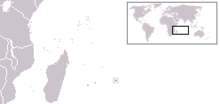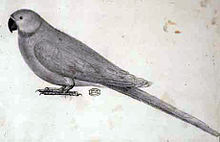
The dodo is an extinct flightless bird that was endemic to the island of Mauritius, which is east of Madagascar in the Indian Ocean. The dodo's closest relative was the also-extinct and flightless Rodrigues solitaire. The two formed the subfamily Raphinae, a clade of extinct flightless birds that were a part of the family which includes pigeons and doves. The closest living relative of the dodo is the Nicobar pigeon. A white dodo was once thought to have existed on the nearby island of Réunion, but it is now believed that this assumption was merely confusion based on the also-extinct Réunion ibis and paintings of white dodos.

The Rodrigues solitaire is an extinct flightless bird that was endemic to the island of Rodrigues, east of Madagascar in the Indian Ocean. Genetically within the family of pigeons and doves, it was most closely related to the also extinct dodo of the nearby island Mauritius, the two forming the subfamily Raphinae. The Nicobar pigeon is their closest living genetic relative.

The Réunion ibis or Réunion sacred ibis is an extinct species of ibis that was endemic to the volcanic island of Réunion in the Indian Ocean. The first subfossil remains were found in 1974, and the ibis was first scientifically described in 1987. Its closest relatives are the Malagasy sacred ibis, the African sacred ibis, and the straw-necked ibis. Travellers' accounts from the 17th and 18th centuries described a white bird on Réunion that flew with difficulty and preferred solitude, which was subsequently referred to as the "Réunion solitaire".

Psittacula, also known as Afro-Asian ring-necked parrots, is a genus of parrots from Africa and Southeast Asia. It is a widespread group with a clear concentration of species in south Asia, but also with representatives in Africa and the islands of the Indian Ocean. This is the only genus of parrot which has the majority of its species in continental Asia. Of all the extant species only Psittacula calthropae, Psittacula caniceps and Psittacula echo do not have a representative subspecies in any part of mainland continental Asia. The rose-ringed parakeet, Psittacula krameri, is one of the most widely distributed of all parrots.

The echo parakeet is a species of parrot endemic to the Mascarene Islands of Mauritius and formerly Réunion. It is the only living native parrot of the Mascarene Islands; all others have become extinct due to human activity. Two subspecies have been recognised, the extinct Réunion parakeet and the living echo parakeet, sometimes known as the Mauritius parakeet. The relationship between the two populations was historically unclear, but a 2015 DNA study determined them to be subspecies of the same species by comparing the DNA of echo parakeets with a single skin thought to be from a Réunion parakeet, but it has also been suggested they did not constitute different subspecies. As it was named first, the binomial name of the Réunion parakeet is used for the species; the Réunion subspecies thereby became P. eques eques, while the Mauritius subspecies became P. eques echo. Their closest relative was the extinct Newton's parakeet of Rodrigues, and the three are grouped among the subspecies of the rose-ringed parakeet of Asia and Africa.

The broad-billed parrot or raven parrot is a large extinct parrot in the family Psittaculidae. It was endemic to the Mascarene island of Mauritius. The species was first referred to as the "Indian raven" in Dutch ships' journals from 1598 onwards. Only a few brief contemporary descriptions and three depictions are known. It was first scientifically described from a subfossil mandible in 1866, but this was not linked to the old accounts until the rediscovery of a detailed 1601 sketch that matched both the subfossils and the accounts. It is unclear what other species it was most closely related to, but it has been classified as a member of the tribe Psittaculini, along with other Mascarene parrots. It had similarities with the Rodrigues parrot, and may have been closely related.

The Seychelles parakeet or Seychelles Island parrot is an extinct species of parrot that was endemic to the Seychelles in the Indian Ocean. It was scientifically named Palaeornis wardi by the British ornithologist Edward Newton in 1867, and the specific name honours the British civil commissioner Swinburne Ward who procured the specimens that formed the basis for the description. It was found on the islands of Mahé, Silhouette, and possibly Praslin. Ten skin specimens exist today, but no skeletons. Though the species was later moved to the genus Psittacula, genetic studies have led some researchers to suggest it should belong in a reinstated Palaeornis along with the closely related Alexandrine parakeet (P. eupatria) of Asia.

The hoopoe starling, also known as the Réunion starling or Bourbon crested starling, is a species of starling that lived on the Mascarene island of Réunion and became extinct in the 1850s. Its closest relatives were the also-extinct Rodrigues starling and Mauritius starling from nearby islands, and the three apparently originated in south-east Asia. The bird was first mentioned during the 17th century and was long thought to be related to the hoopoe, from which its name is derived. Some affinities have been proposed, but it was confirmed as a starling in a DNA study.
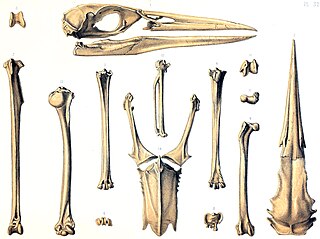
The Rodrigues night heron is an extinct species of heron that was endemic to the Mascarene island of Rodrigues in the Indian Ocean. The species was first mentioned as "bitterns" in two accounts from 1691–1693 and 1725–1726, and these were correlated with subfossil remains found and described in the latter part of the 19th century. The bones showed that the bird was a heron, first named Ardea megacephala in 1873, but moved to the night heron genus Nycticorax in 1879 after more remains were described. The specific name megacephala is Greek for "great-headed". Two related extinct species from the other Mascarene islands have also been identified from accounts and remains: the Mauritius night heron and the Réunion night heron.

The Rodrigues rail, also known as Leguat's gelinote or Leguat's rail, is an extinct species of the rail family that was endemic to the Mascarene island of Rodrigues. The bird was first documented from life by two accounts from 1691–93 and 1725–26. Subfossil remains were later discovered and correlated with the old accounts in 1874, and the species was named E. leguati in Leguat's honour. It is generally kept in its own genus, Erythromachus, but has sometimes been assigned to the genus Aphanapteryx along with its close relative the red rail of Mauritius; their relationship with other rails is unclear.
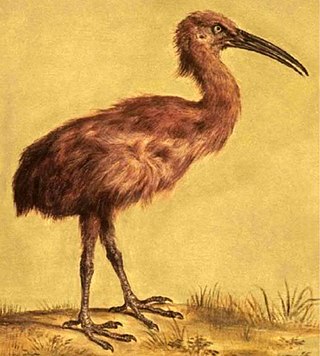
The red rail is an extinct species of rail that was endemic to the Mascarene island of Mauritius, east of Madagascar in the Indian Ocean. It had a close relative on Rodrigues island, the likewise extinct Rodrigues rail, with which it is sometimes considered congeneric, but their relationship with other rails is unclear. Rails often evolve flightlessness when adapting to isolated islands, free of mammalian predators, and that was also the case for this species. The red rail was a little larger than a chicken and had reddish, hairlike plumage, with dark legs and a long, curved beak. The wings were small, and its legs were slender for a bird of its size. It was similar to the Rodrigues rail, but was larger, and had proportionally shorter wings. It has been compared to a kiwi or a limpkin in appearance and behaviour.
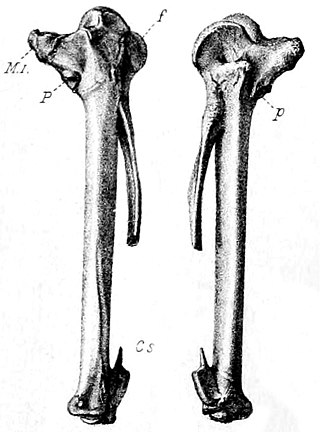
The Mauritius sheldgoose, also known as the Mauritius shelduck, is an extinct species of sheldgoose that was endemic to the island of Mauritius. While geese were mentioned by visitors to Mauritius in the 17th century, few details were provided by these accounts. In 1893, a carpometacarpus wing-bone and a pelvis from the Mare aux Songes swamp were used to name a new species of comb duck, Sarcidiornis mauritianus. These bones were connected to the contemporary accounts of geese and later determined to belong to a species related to the Egyptian goose and placed in the sheldgoose genus Alopochen. The Mauritius and Réunion sheldgoose may have descended from Egyptian geese that colonised the Mascarene islands.

The Mascarene parrot or mascarin is an extinct species of parrot that was endemic to the Mascarene island of Réunion in the western Indian Ocean. The taxonomic relationships of this species have been subject to debate; it has historically been grouped with either the Psittaculini parrots or the vasa parrots, with the latest genetic study favouring the former group.

The Rodrigues parrot or Leguat's parrot is an extinct species of parrot that was endemic to the Mascarene island of Rodrigues. The species is known from subfossil bones and from mentions in contemporary accounts. It is unclear to which other species it is most closely related, but it is classified as a member of the tribe Psittaculini, along with other Mascarene parrots. The Rodrigues parrot bore similarities to the broad-billed parrot of Mauritius, and may have been related. Two additional species have been assigned to its genus, based on descriptions of parrots from the other Mascarene islands, but their identities and validity have been debated.

The Rodrigues scops owl, also known as Rodrigues owl, Rodrigues lizard owl, Leguat's owl, or Rodrigues little owl, was a small owl. It lived on the Mascarene island of Rodrigues, but it is nowadays extinct. It is part of the three Mascarene owls, formerly classified in the genus Mascarenotus, although they are now classified in the genus Otus. Like many of the Mascarene land-birds, the genus was a distinct relative to South-East Asian taxa, in this case apparently being a descendant of the direct ancestor of the Oriental scops owl. This insular scops owl had evolved gigantism, becoming twice as large and four times heavier than its continental ancestor.

The Réunion swamphen, also known as the Réunion gallinule or oiseau bleu, is a hypothetical extinct species of rail that was endemic to the Mascarene island of Réunion. While only known from 17th- and 18th-century accounts by visitors to the island, it was scientifically named in 1848, based on the 1674 account by Sieur Dubois. A considerable literature was subsequently devoted to its possible affinities, with current researchers agreeing it was derived from the swamphen genus Porphyrio. It has been considered mysterious and enigmatic due to the lack of any physical evidence of its existence.
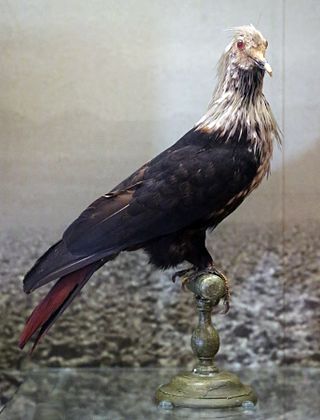
The Mauritius blue pigeon is an extinct species of blue pigeon formerly endemic to the Mascarene island of Mauritius in the Indian Ocean east of Madagascar. It has two extinct relatives from the Mascarenes and three extant ones from other islands. It is the type species of the genus of blue pigeons, Alectroenas. It had white hackles around the head, neck and breast and blue plumage on the body, and it was red on the tail and the bare parts of the head. These colours were thought similar to those of the Dutch flag, a resemblance reflected in its French common name, Pigeon Hollandais. The juveniles may have been partially green. It was 30 cm (12 in) long and larger and more robust than any other blue pigeon species. It fed on fruits, nuts, and molluscs, and was once widespread in the forests of Mauritius.

The Rodrigues starling is an extinct species of starling that was endemic to the Mascarene island of Rodrigues. Its closest relatives were the Mauritius starling and the hoopoe starling from nearby islands; all three are extinct and appear to be of Southeast Asian origin. The bird was only reported by French sailor Julien Tafforet, who was marooned on the island from 1725 to 1726. Tafforet observed it on the offshore islet of Île Gombrani. Subfossil remains found on the mainland were described in 1879, and were suggested to belong to the bird mentioned by Tafforet. There was much confusion about the bird and its taxonomic relations throughout the 20th century.

The Mascarene grey parakeet, Mauritius grey parrot, or Thirioux's grey parrot, is an extinct species of parrot which was endemic to the Mascarene Islands of Mauritius and Réunion in the western Indian Ocean. It has been classified as a member of the tribe Psittaculini, along with other parrots from the Islands.

Julian Pender Hume is an English palaeontologist, artist and writer who lives in Wickham, Hampshire. He was born in Ashford, Kent, and grew up in Portsmouth, England.

